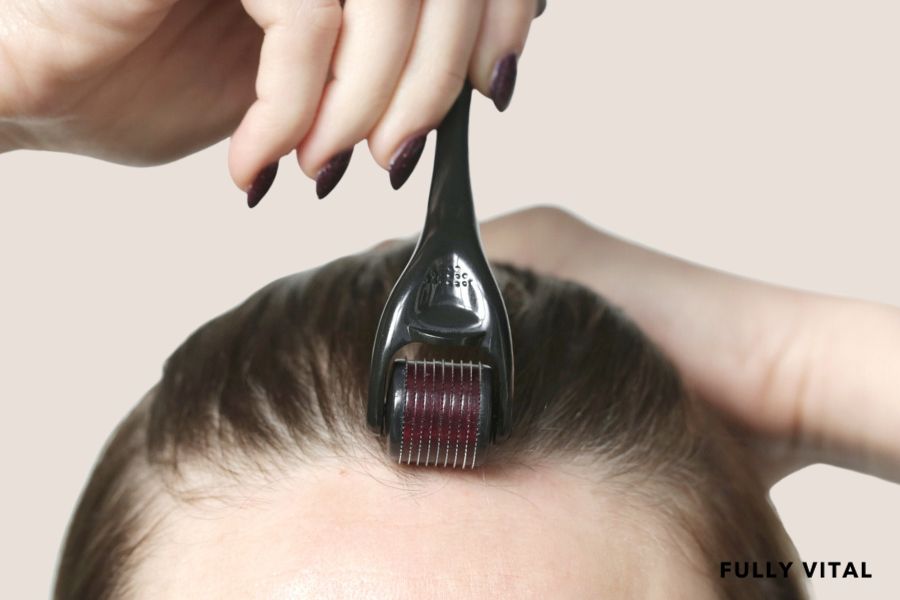
Microneedling Hairline: Stimulate Hair Growth With This Game-Changing Technique
Microneedling hairline, also known as scalp microneedling or micro-needling therapy, is a revolutionary technique used to stimulate hair growth.
This procedure involves the use of a microneedling device, which creates tiny punctures on the scalp's surface.
Find out more about this game-changing technique and how it can help you achieve thicker and healthier hair.

I LOVE MY HAIR NOW
FullyVital hair serum and hair vitamins made tremendous improvements in my hair. I truly love my hair now.
Dorit S.,
What Is A Microneedling Hairline?
Microneedling hairline, also known as scalp microneedling or micro-needling therapy, is a revolutionary technique used to stimulate hair growth.1
This procedure involves the use of a microneedling device, which creates tiny punctures on the scalp's surface.

Why Is Microneedling Hairline Important?
Microneedling hairline is gaining popularity among women of all hair types who are looking to promote hair growth.
This technique not only helps to strengthen the hair follicles but also stimulates blood circulation in the scalp, leading to healthier and thicker hair.
How Does Microneedling Hairline Work?
During a microneedling hairline session, the skilled practitioner gently rolls a derma roller or derma pen over the scalp.
These handheld devices are equipped with tiny needles that create controlled micro-injuries on the scalp's upper layer.
These micro-injuries trigger the natural healing process of the body and stimulate the production of collagen and elastin.
What Are The Benefits Of Microneedling Hairline?
Hair Regrowth
Microneedling hairline stimulates dormant hair follicles, promoting new hair growth.
Improved Hair Thickness
The enhanced blood flow and collagen production from microneedling lead to thicker and healthier hair.
Reduced Hair Loss
This technique minimizes hair loss by strengthening hair follicles and reducing scalp inflammation.
Enhanced Absorption Of Topical Products
Microneedling enhances the absorption of topical hair growth products such as serums and oils, making them more effective.2
How Often Should I Microneedle My Hairline?
To achieve optimal results with microneedling for your hairline, it is generally recommended to undergo the treatment once every 1-2 weeks.
This frequency allows for adequate healing time between sessions while still maintaining a consistent stimulation of the hair follicles.
However, it is essential to consult a dermatologist or a trained professional who can assess your specific condition and provide personalized recommendations.
They may take into account factors such as the severity of hair loss, overall scalp health, and individual response to the treatment when determining the ideal frequency for microneedling sessions.
How Long Does It Take For Microneedling Hair Results?
The timeline for seeing noticeable results from microneedling for the hairline can vary from person to person.
Generally, significant improvements in hair growth can be observed within 3-6 months of regular microneedling sessions.
However, it's important to understand that individual hair growth cycles and other factors can influence the time it takes to see results.
Some individuals may experience more rapid hair regrowth, while others may require longer treatment durations to achieve the desired outcome.
Consistency, patience, and following the recommended treatment regimen are key to obtaining the best possible results.
What Do You Normally Do After Microneedling Hairline?
After microneedling your hairline, there are several essential post-treatment steps to maximize the benefits and ensure proper healing:
- Hydrate: Keep your scalp hydrated by applying a non-irritating and gentle moisturizer. This helps soothe the skin and promote healing.3 It is important to choose products specifically formulated for the scalp and free from harsh chemicals that may cause irritation.
- Avoid Sun Exposure: Protect your scalp from direct sun exposure for a few days following the procedure. The newly punctured skin is more susceptible to damage from harmful UV rays, which can slow down the healing process and potentially cause adverse effects. If necessary, wear a hat or use sunscreen with a high SPF to shield your scalp.
- Avoid Harsh Hair Products: Refrain from using harsh hair styling products, such as hairspray or gel, immediately after microneedling. These products may contain chemicals that can irritate the scalp and hinder the healing process. Opt for gentle, sulfate-free hair care products instead.
- Limit Physical Activity: Avoid engaging in strenuous activities and exercises for the first 24-48 hours after microneedling. Excessive sweating and friction on the scalp can potentially cause irritation and compromise the healing process. It is best to allow your scalp to rest and recover during this time.
- Follow the Practitioner's Instructions: Your microneedling practitioner may provide specific instructions based on your unique needs and condition. Always follow their guidance for the best post-treatment care. They may give you personalized recommendations regarding hair care, products to use or avoid, and any additional precautions to take.
Does Microneedling Scalp Promote Hair Growth?
Yes, microneedling on the scalp has been shown to promote hair growth.
The process of microneedling creates small punctures in the scalp, which stimulates blood circulation and triggers the production of growth factors.
This increased blood flow and growth factor release can encourage hair follicles to enter the active growth phase and produce thicker, healthier hair strands.
Microneedling also helps to remove any buildup of dead skin cells or excess sebum, which can clog hair follicles and inhibit proper hair growth.
By creating a more conducive environment for hair regrowth, microneedling can be a valuable treatment option for individuals looking to address hair loss or promote overall hair health.
Are There Any Downsides To Microneedling Hairline?
While microneedling hairline is generally safe and effective, there are a few potential downsides to be aware of:
Discomfort
Some individuals may experience mild discomfort during the procedure, although it is usually well-tolerated.
Temporary Scalp Redness
After microneedling, the scalp may appear slightly red, but this typically resolves within a day or two.
Risk Of Infection
Proper hygiene and sterilization of the microneedling device are crucial to prevent infections. It's important to ensure that the procedure is conducted by a trained professional.
Possible Bruising
In rare cases, microneedling can cause minor bruising on the scalp. This usually fades within a few days.
What Are The Alternatives To Microneedling Hairline?
If microneedling hairline doesn't seem like the right fit for you, there are alternative treatments available to promote hair growth.
These include:
- Platelet-Rich Plasma (PRP) Therapy: PRP therapy involves injecting platelet-rich plasma, derived from your own blood, into the scalp. This stimulates hair growth by promoting cell regeneration and collagen production.
- Low-Level Laser Therapy (LLLT): LLLT is a non-invasive treatment that uses a specialized laser device to stimulate hair follicles, promoting hair growth.
- Topical Hair Growth Products: Many topical hair growth products, such as minoxidil or essential oil blends, can be applied directly to the scalp to improve hair health and promote growth.
Reclaim Your Youthful Hair With Fully Vital!
Ready to turn back the clock on your hair? Start your journey to a more youthful you today! |
Final Thoughts On Microneedling Hairline
Microneedling hairline is a game-changing technique that offers numerous benefits for promoting hair growth.
By stimulating the hair follicles, improving blood circulation, and enhancing the absorption of hair growth products, microneedling has emerged as a powerful solution for those looking to strengthen and restore their hairline.
With its ability to address hair loss, improve hair thickness, and reduce scalp inflammation, microneedling hairline has become an important topic for the Hair Growth Product Company.
By understanding the history, importance, and effectiveness of this technique, we can continue to provide innovative solutions to our customers who seek to maintain a healthy relationship with their locks.
At Fully Vital, we offer a variety of hair growth products specifically designed to stop the aging of your hair and promote overall hair health.
Explore our range of high-quality products and discover how microneedling hairline, in combination with our hair growth solutions, can help you achieve the luscious locks you desire.
Invest in the health and vitality of your hair today and unlock its full potential.
Your hair deserves the care it needs to flourish, and we're here to support you every step of the way.
Frequently Asked Questions About Microneedling Hairline
How often should I microneedle my scalp for hair growth?
If you are using microneedling to promote hair growth on your scalp, it is recommended to undergo the procedure once every 1-2 weeks.
This frequency allows for adequate healing time and consistent stimulation of the hair follicles, leading to better results.
Can microneedling damage your hair?
When performed by a trained professional, microneedling hairline is generally safe and should not cause damage to your hair.
However, it is important to follow proper hygiene and sterilization procedures to minimize the risk of infection or other complications.
Using a clean and high-quality microneedling device is also crucial to ensure the best outcomes.
Can I do microneedling at home for my hairline?
While it is possible to perform microneedling at home, it is highly recommended to seek the expertise of a trained professional for microneedling hairline.
They have the knowledge and experience to safely and effectively perform the procedure, ensuring the best possible outcomes.
What size microneedle should I use for my hairline?
For microneedling hairline, it is generally recommended to use a needle size ranging from 0.3mm to 1.0mm.
However, the optimal size depends on individual factors and the advice of a professional.
It is crucial to consult with a trained practitioner who can assess your specific needs and determine the appropriate needle size.
What depth should I microneedle my scalp for hair growth?
When microneedling your scalp for hair growth, it is generally recommended to use a needle depth between 0.5mm and 1.5mm.
However, the specific depth may vary depending on factors such as the thickness of your scalp and the advice of a professional.
It is important to consult with a trained practitioner to determine the appropriate depth for your specific needs.
How painful is microneedling scalp?
During microneedling scalp treatments, some individuals may experience mild discomfort or a tingling sensation.
However, the procedure is generally well-tolerated and not excessively painful.
If needed, a topical numbing cream can be applied prior to the procedure to further minimize any discomfort.
What should you not do after microneedling your scalp?
After microneedling your scalp, it is important to avoid certain activities that may hinder the healing process or cause irritation.
Here are some things you should not do after microneedling your scalp:
- Avoid Direct Sun Exposure: Protect your scalp from direct sunlight for a few days following the procedure.
- Avoid Harsh Hair Products: Refrain from using harsh hair styling products or chemicals on your scalp immediately after microneedling.
- Do Not Scratch or Pick at Your Scalp: Avoid scratching or picking at your scalp to prevent infection and promote proper healing.
Can you use hair dye after microneedling treatment?
It is generally recommended to wait at least 48 hours after microneedling your scalp before using hair dye or other chemical treatments.
This waiting period allows your scalp's micro-injuries to heal and reduces the risk of irritation or adverse reactions.
It is best to consult with a professional for specific guidance based on your individual situation.
Sources:
- Dhurat, R., Sukesh, M., Avhad, G., Dandale, A., Pal, A., & Pund, P. (2013). A randomized evaluator blinded study of effect of microneedling in androgenetic alopecia: A pilot study. International Journal of Trichology, 5(1), 6. https://doi.org/10.4103/0974-7753.114700
- Yadav, S., & Singh, A. (2016). Microneedling: Advances and widening horizons. Indian Dermatology Online Journal, 7(4), 244–254. https://doi.org/10.4103/2229-5178.185468
- Rathi, S. K., & D′Souza, P. (2015). Shampoo and conditioners: What a dermatologist should know? Indian Journal of Dermatology, 60(3), 248. https://doi.org/10.4103/0019-5154.156355







